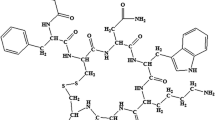Abstract.
Radiolabelled tumour receptor-binding peptides can be used for in vivo scintigraphic imaging. Recently, the somatostatin analogue [Tyr3]octreotide (d-Phe-c(Cys-Tyr-d-Trp-Lys-Thr-Cys)-Thr(ol)) was derivatized with the chelator DOTA (tetra-azacyclododecane-tetra-acetic acid), enabling stable radiolabelling with both the high-energy beta particle-emitter yttrium-90 and the Auger electron-emitter indium-111. The thus produced radiolabelled compounds are promising for peptide receptor radionuclide therapy. Our previous in vitro and in vivo (rat) experiments with these radiolabelled compounds showed favourable binding and biodistribution characteristics with high uptake and retention in the target organs. We also demonstrated receptor-specific, time- and temperature-dependent internalization of radiolabelled [DOTA0,Tyr3]octreotide in somatostatin receptor subtype 2 (sst2)-positive rat pancreatic tumour cell lines. In this study we have investigated the effects of differences in the amount of injected peptide on tissue distribution of 111In-labelled [DOTA0,Tyr3]octreotide in normal, i.e. non-tumour-bearing, and CA20948 tumour-bearing rats. This was done in order to find the amount of peptide at which the highest uptake in target tissues is achieved, and thereby to increase the potential of radionuclide therapy while simultaneously ensuring the lowest possible radiotoxicity in normal organs. Uptake of radiolabelled [DOTA0,Tyr3]octreotide in sst2-positive organs showed different bell-shaped functions of the amount of injected peptide, being highest at 0.05 (adrenals), 0.05–0.1 (pituitary and stomach) and 0.25 (pancreas) µg. Uptake in the tumour was highest at 0.5 µg injected peptide. The highest uptake was found at peptide amounts that were lower than those reported for [111In-DTPA0]octreotide ((d-Phe-c(Cys-Phe-d-Trp-Lys-Thr-Cys)-Thr(ol), DTPA = diethylene-triamine-penta-acetic acid), consistent with the higher receptor affinity of the first compound. Our observations of mass-dependent differences in uptake of radiolabelled [DOTA0, Tyr3]octreotide, being the resultant of a positive effect of increasing amounts of peptide on, for example, receptor clustering and a negative effect of receptor saturation, are of consequence for rat radionuclide therapy studies with radiolabelled peptides and may also be of consequence for human radionuclide therapy studies with this compound.
Similar content being viewed by others
Author information
Authors and Affiliations
Additional information
Received 6 January and in revised form 16 February 1999
Rights and permissions
About this article
Cite this article
de Jong, M., Breeman, W., Bernard, B. et al. Tumour uptake of the radiolabelled somatostatin analogue [DOTA0,TYR3]octreotide is dependent on the peptide amount. Eur J Nucl Med 26, 693–698 (1999). https://doi.org/10.1007/s002590050439
Issue Date:
DOI: https://doi.org/10.1007/s002590050439




